Quick: Think of a fish. The sort of fish that you keep in your home, the sort of fish which properly calls a clear fishbowl its habitat. You’re likely thinking of a guppy—the single most popular aquarium fish there is. If you’ve ever considered owning a fish, you might have been thinking of a guppy—as they’re very easy to procure, easy to care for, and easy to feed.
Species Summary
You might not have thought of them beyond that, though! What are guppy fish, exactly, and where do they come from? Guppies are very small fish, between half an inch and two inches long, and they come in every color under the sea. Originally from South America, they are now indigenous everywhere due precisely to their popularity as easily cared for children’s pets.
Their Latin name is Poeciliidae, and there are several subgenera within that category, such as the Wingei guppy and the Reticulata guppy. The one you’re likely familiar with is the Reticulata guppy, so that’s the one that we’ll be talking about today.
Types of guppy fish (Color, Pattern and Tail Shape)
As we mentioned above, guppies can come in hundreds of different colors—so much so that they earned themselves the name of Rainbow Fish, simply because of their thousands of different hues. (They also have the unofficial moniker of ‘Millions Fish,’ because their breeding rate is so high!)
Because of their breeding rate and ease of care, guppies are often imported into areas with high mosquito populations to control the number of mosquitoes attacking the human population.
This has been done in South Asia, in fact, with great success. As far as the pattern of the guppy fish, in addition to their bright color they have leopard-like flecks of black across their body.
Their tail shape is likely the most distinctive thing about them, as it fans out in a beautiful peacock-esque shape behind them, flitting through the water like a delicate leaf.
The patterns swirling across their backs can come in several distinctive genres:
- The ‘Cobra’, which will have stars across the body as well as zebra-like vertical barring
- The ‘Snakeskin’, which will have more of a pattern of interlinked chains, as well as the more typical stars
- The ‘Tuxedo’, which will feature a front half and a back half rocking two distinctly different colors
The fans are larger on the males, as, just like in many types of animal’s mating rituals, it’s up to the male to attract the female. The males will flutter their attractive fins beguilingly at the female they’ve judged most likely to help them carry on their DNA, and after that, the game will be on.
Behavior
Guppies are naturally very social fish; if they’re not waving their fins at each other and are instead hiding behind tank decorations or rocks, they could be very sick.
You’ll want to keep your guppies in groups, not only because it’s better for them, but because it’ll be more fun for you; after all, the ‘Rainbow Fish’ are undoubtedly best when viewed together. Because the males have the more peacock-y tails, if you’re not planning on breeding them, it’s best to invest in just male guppy fish.
Tank Size
The minimum recommended tank size is approximately five gallons, but most people go for a ten gallon tank—especially if you’re going to have more than a couple of guppies living together, which is also recommended for their mental health.
Make sure that you set the tank up so that you can always be cycling the water out properly so you can be sure that you’re exchanging the bad bacteria for good ones—that’s extremely important for your fish’s health.
Guppy Tank Mates
Guppies should always be together, but just how together they are and just what else you put in the tank should be dependent upon what you want to do with the fish. Are you planning on just keeping them for show? Or are you planning on setting up a breeding system? This will determine whether you keep only males, only females, or a number of each in the tank, as an example of one consideration you’ll have to have.
If you’re planning on keeping the guppies for show, you’ll want to fill your tank with plants and rocks and other toys for the guppies to interact with; if you’re planning on breeding them, fewer distractions for the guppies are better—and you’ll want to leave the bottom of the tank open, so you can clean it easily.
The best bet, whether you’re keeping males, females, or a mixture, is to keep one guppy per two gallons of water. Therefore, the size of your tank will be the ultimate determining factor in how many guppies you are able to maintain.
As far as keeping the guppies in a tank with other species of fish, the guppy is a very peaceful creature and will be fine with most other species. Our one recommendation would be to simply ensure that you’re not keeping the guppies in the tank with any particularly aggressive or carnivorous sort of fish, as the guppy doesn’t have much in the way of a defense system and will likely be the first to be thought of as food.
Feeding your Guppies
Guppies are as versatile with their preferred cuisine as they are with everything else! As their diet is dependent upon what was naturally available to them in their original habitat, guppies are naturally omnivores; they will eat both plant and animal matter.
One of the main things they eat in the wild is mosquito larvae, which is why they were imported en masse to South Asia to control the mosquito problem.
However, when they’re in your home, the majority of what they should be eating is simply fish flakes. You should make sure that you’re choosing good ones! Protein-rich fish flakes with an absence of filler ingredients are best.
To mix it up every once in a while, you can throw a few slices of cucumber or a shrimp in the tank, and watch your guppies as they have a feast.
Setting Up Your Guppy Fish Tank
So you want to bring home some beautiful, easily cared for guppies? Congratulations! You do have a few pieces of homework, however, before you can begin. Let’s discuss setting up your fish tank properly.
Nitrogen Cycle
The Nitrogen cycle is the number one most important thing you have to do prior to introducing fish to your tank; nitrogen is as crucial to the fish and their survival as oxygen is to us! The nitrogen cycle has more to do with cleaning the tank then making it breathable.
The waste your fish will produce gives off ammonia into the water, which is toxic to fish. Nitrogenating the water will help remove what is toxic and re-establish beneficial bacteria, so that your fish have a fighting chance.
Substrate
The best substrate for guppies is, fortunately, also the easiest for you to get your hands on! Sand is super-fine, cheap, and likely of a good enough size that it won’t easily get stuck in your fish’s mouths or anywhere else in their systems. For this reason, most professional fish-havers choose sand when it comes to the best substrate.
Filtration
Aside from the natural machinations of the nitrogen cycle, you will be needing additional filtration systems. This is true whenever you try to board a living thing! However, there’s a very simple solution for needing a filtration system: buy a filter. A power filter, though not necessary, is definitely easier for first-time fish owners; as long as you keep it powered and on, it will take care of most of the chores of cleaning out your tank for you.
For a good rule of thumb regarding the efficacy of your filter, just remember the following equivalency: for a ten gallon tank, use a filter that is able to cycle fifty gallons in a given 60 minute period.
Lighting
Remember, again, where your fishes are naturally from—the thing you’re trying to recreate with all of these conditions! Guppies are flexible in terms of lighting; keep it bright during the day, and dark at night for their sleep cycles.
Plants and Decorations
If you’re keeping your guppies for show instead of actively trying to breed them, definitely put some plants and decorations in there! Rock formations for the guppies to swim around and several different kinds of plants will help keep them happy.
Lining the bottom of the tank with some moss will give them a natural place to swim and hide in, which is a good thing for them to have if they need a minute.
Guppy Habitat and Tank Conditions
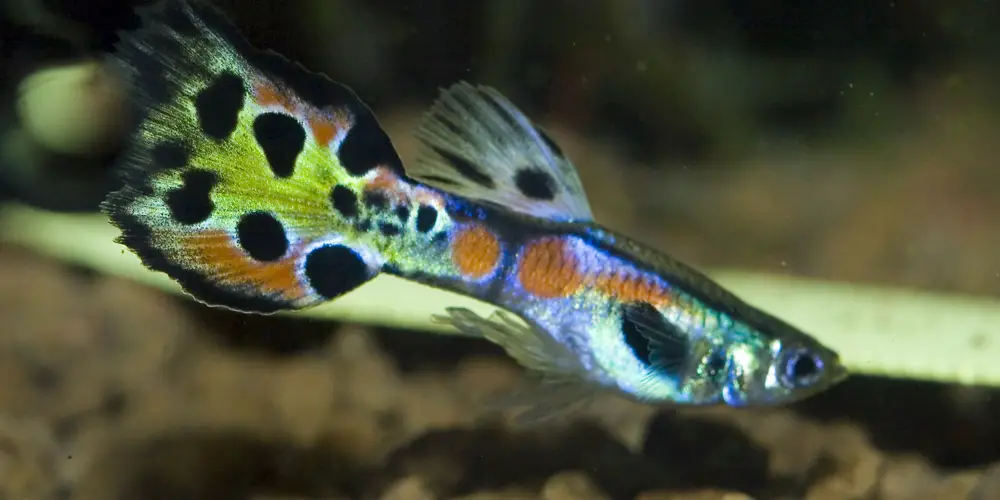
Water Temperature for Guppies
Remember wen you’re putting together the tank that the natural habitat of the guppy fish is the warm, extremely temperate waters found around South America. You should therefore try to replicate that environment as best you can when you’re making them your home away from home—in your living room or office.
Warm water, preferably between 75 and 82 degrees Fahrenheit, is preferable. You’ll likely have to use a water heater to obtain this window.
Always remember to leave the heater at one distinct end of your fish’s tank! Have a thermometer at the other end, though, so that you can easily check to ensure that the water is heating evenly throughout.
Water Flow for Guppies
You should aim to be cycling the water so there’s about a 25% change in water per week, whatever the flow looks like for you to obtain that goal—but the flow should definitely be constant, as that best mimics the water that they’re used to. Failing to meet this goal may result in your guppies becoming sick (you’ll be able to tell this because your social fish will start to seclude themselves).
Water Type for Guppies
As long as you keep your water in the right balance of acids/bases, use a filtration system to keep it clean, and keep it very warm, whatever water type you use should be more than fine.
Tank Water PH
Guppies are naturally very tolerant, so they can live successfully through a range of pH’s, particularly anywhere between 5.5-8.5. However, this does not mean that this is the best place for them to be! See if you can aim for an in-tank pH of about 7.0-7.2 for their best bet at health and happiness.
Ammonia, Nitrite, And Nitrates
Ammonia is the byproduct of fish’s wastes that you will be removing with a properly calibrated nitrogen cycle! Test your water frequently to make sure that the ratio of ammonia, nitrite, and nitrates is in a good place—and dechlorinate your water if this isn’t the case.
Breeding Guppies
Guppies are not what we’d consider shy; it’ll likely be more difficult to stop them from breeding then to try to instigate it, as long as you set up the tank and their environment properly so that it’s conducive to their mating habits.
Choose The Best Guppies for Breeding
Guppies are not shy; as long as you put healthy males and females together in a 2 males to 3 females ratio, you will be able to breed them.
How to Tell the Sex of a Guppy
Guppies are very easy to tell apart, male from female. As previously mentioned, the males are usually brighter in color and have a particularly large fin. However, other than the fin, males are actually smaller than females.
Females often do have a very dark spot behind their main fin, called the gravid spot. This spot gets darker during pregnancy and is often one of the first registered signs that mating has completed successfully and your guppies are expecting.
Creating Your Breeding Environment
Separate Breeding Tank
Guppies can tend to eat their young (or anyone’s young) as they are strange and don’t seem quite like other fish to them yet; so, often, people do choose to put an expecting mother in a separate breeding tank about a week before she’s going to give birth, watch her carefully, and then remove her once she’s spawned her fry and before she tries to eat any of them. Setting up this secondary tank should be very similar to setting up the first tank.
Creating The Water Conditions for Breeding
Again, as the waters to which guppies are indigenous are the warm South American waters, the waters of the breeding tank in particular should be very warm. This will help protect the fry in their earliest days, when they are extremely small.
Line the bottom of the breeding tank with a dense plant such as moss, which will allow the fry to swim to and hide within while they are small—this is protective and instinctive, and will help them survive.
The Spawning Process
Guppies are ovoviviparous, which means that they have the fish inside of eggs—but the eggs grow inside of their bodies. Therefore, much of the spawning process happens rather invisibly.
Feeding Guppy Fry
The baby fish use the egg for nourishment during the earliest days of their lives; when the nutrients from the egg have been consumed and the baby fish has grown to a size where it can survive outside of its mother, they hatch inside the mother, and then are born after that.
The gestation of a guppy is only about one month, making breeding guppies a relatively sustainable situation if it’s something that you’d like to try.
Common Diseases
Guppies are relatively healthy; a disease called IcH is your one fear.
The best tips we have for making sure your guppies don’t get sick are:
- Make sure that you’re always checking their water to make sure that the water is cycling naturally, that the pH is in the right place, and that it’s in a good temperature window.
- Change the water regularly.
- Before you put anything new within the tank, rinse it off, or give it a time in quarantine before you expose the fish to it.
Don’t stress them out! Feed them regularly, and don’t overcrowd them. Stressed guppies easily become sick guppies.
How Large Do Guppies Grow?
Guppies grow to be about 2 inches long; smaller, if they’re males.
Average Cost of Guppies?
Guppies are a cheap breed of fish; one fish will only cost you a dime.
Do guppies eat their own babies?
Mothers will eat their young, which is why many people choose to breed in a separate tank.
Guppies Keep Dying?
If your guppies keep dying, make sure that you’ve been cleaning their tank appropriately, and check the water for undue concentrations of chemicals. If everything else looks okay, go see a veterinarian for more information.
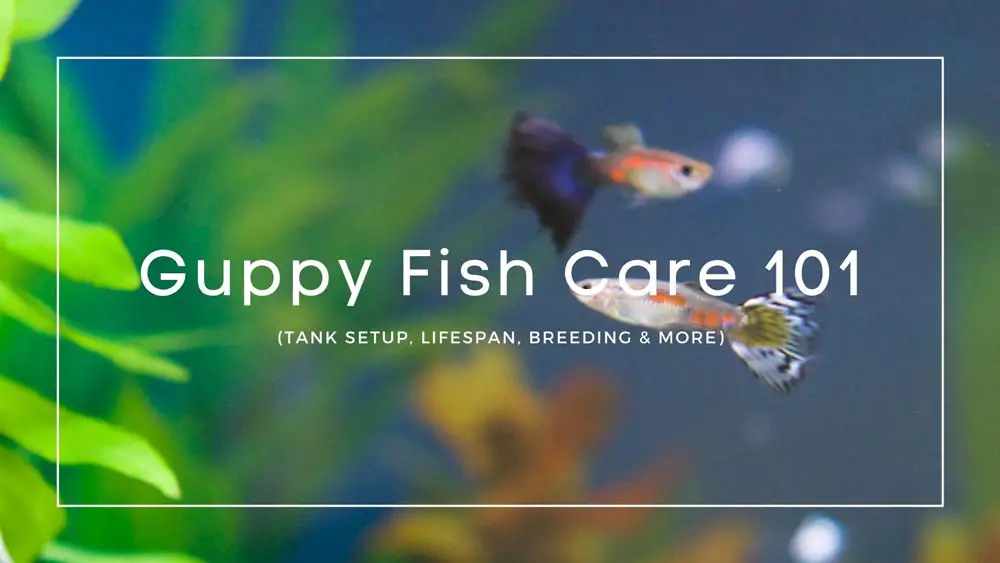

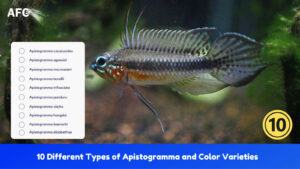
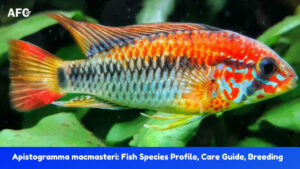
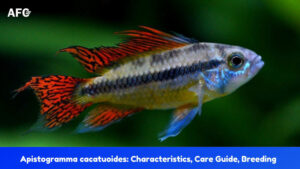

1 thought on “Guppy Fish 101: Types, Care, Lifespan, Breeding And Tank Mates”
Thanks Jeff